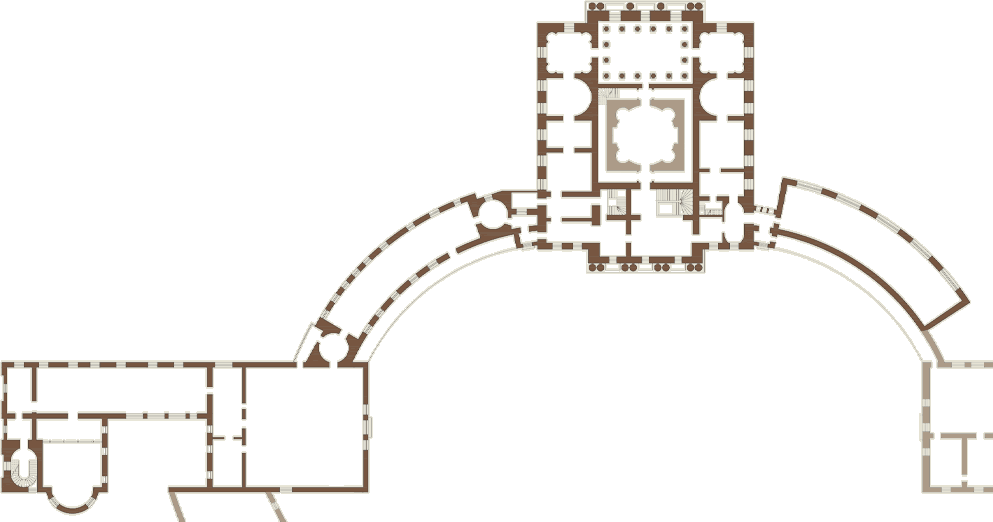The Egyptian Vestibule
Загрузка панорамы...
In the 18th century, the Egyptian Vestibule was called Lower Seni (Russian for "entryway"). It is the main entrance to the palace; its architectural and artistic solution creates a sense of a smooth transition from the exterior of the palace to the interior: rusticated walls painted in the same tone as the facade of the palace, black stone slabs on the floor, and dark statues near the walls. Through the high glazed doors, a view opens to the Parade Ground and the park, helping to achieve unity with the surrounding nature. Mirrored side walls reflect light, enhancing the illumination of the interior. All the decoration is connected with the theme of nature and the seasons. The ceiling painting in the grisaille technique depicts the activities of cupids, which are allegories of the seasons. For example, cupids warming themselves by the fire represent winter. The twelve statues and the Zodiac signs above them symbolize the twelve months of the year. The decoration of the vestibule was done by Charles Cameron in 1785–1786; the sculptural decor was mainly performed by the sculptor Ivan Prokofiev, and the framing of the medallions was done by Domenico Felice Lamoni. After the fire of 1803, the vestibule was decorated under the direction of the architect Andrey Voronikhin. There is no information about the statues that were lost in the fire. Andrey Voronikhin commissioned Mikhail Aleksandrov-Uvazhny to make new statues based on the Roman-Egyptian figures of Antinous-Osiris and Isis. They are cast from gypsum and painted dark bronze. At the feet of the statues are the attributes of agricultural labor, reflecting the occupations of people in a particular month of the year. The appearance of Egyptian motifs in European art at the turn of the 18th–19th centuries is primarily associated with the famous Egyptian campaigns of Napoleon involving historians and artists, who brought a new wave to the forming Empire style. The general fascination with Egyptian motifs gave rise to the phenomenon of Egyptomania, which went beyond the borders of France. Voronikhin's passion for Egyptian motifs was embodied in many of his design decisions when decorating the interiors of the Pavlovsk Palace in 1804–1809, especially in the furnishings of Maria Feodorovna's apartments. With the appearance of statues of the Egyptian flair, the vestibule got its current name, Egyptian. As for the Zodiac signs, they have been preserved in their original form and shape. The ceiling was originally painted by the decorator Carlo Scotti. After the fire of 1803, Giovanni Battista Scotti painted it anew. The wall of the stairs on the landing of the first march was also painted then. The triangular space of the wall was used to the best effect, presenting a fantastic architectural portal with sitting Egyptian statues and a relief depicting an Egyptian procession moving up the stairs. The sky with clouds is depicted in the center, so this “breakthrough into space” creates a sense of perspective. Thus the Egyptian Vestibule, being a passageway, is freely located in the architectural space of the palace. In 1941, at the beginning of the Nazi occupation, the Egyptian Vestibule served as a place for registering residents of Pavlovsk and surrounding areas before sending them to work in Germany. In the fire of 1944, the ceiling collapsed and two statues on the central wall were destroyed. They were recreated from the preserved originals, except for the attributes at their feet, since no images of them were found. The ceiling painting was recreated by the restorer A. V. Treskin based on old photographs and analogies. As for the sculptures, medallions, and stucco cornice, they were cleared and restored. The decor is complemented by three glass lanterns with a bronze crown (Russia, the last quarter of the 18th century). In the center of the outer wall, there is an authentic cast-iron board removed from the obelisk commemorating the foundation of Pavlovsk with the inscription: “Pavlovsk construction started in 1777”.
The Egyptian Vestibule on the floor plane
- The Egyptian Vestibule
- The Carpet Study
- The Second Interconnecting Study
- The Main Staircase
- The Hall of War
- The Picture Gallery
- The Upper Vestibule
- The Greek Hall
- The Third Interconnecting Study
- The Italian Hall
- The Hall of Peace
- The Throne Room
- The Valet de Chambre Room of Paul I
- The Library of Empress Maria Feodorovna
- The Pantry
- The Dressing Room of Paul I
- The Boudoir
- The Orchestral Room
- The Rossi Study
- The State Bedroom
- The Knights Room
- The Rossi Library
- The Dressing Room of Maria Feodorovna
- The Chevalier Guard Room
- The Small Study of Emperor Paul I
- The Maid of Honour's Room
- The Anteroom (Turkish Room)
- The State Library of Paul I
- The First Interconnecting Study
- The Palace Church

Back
